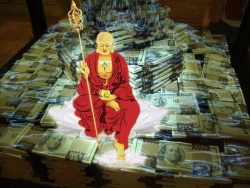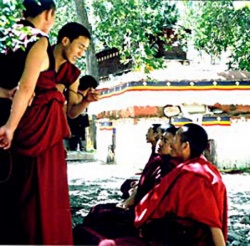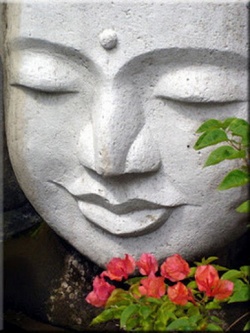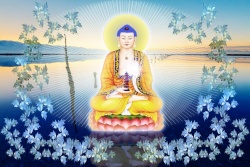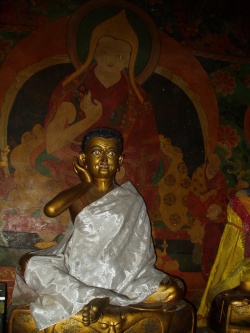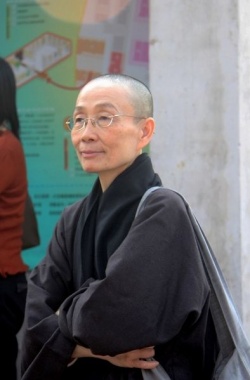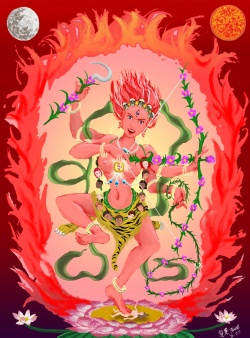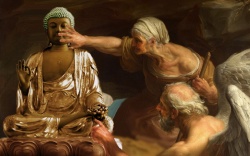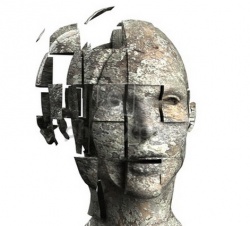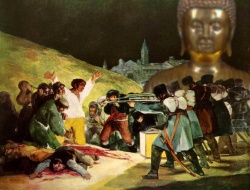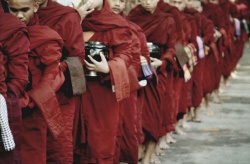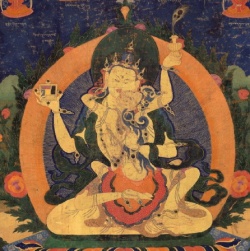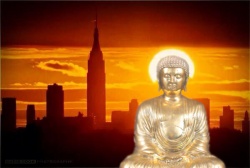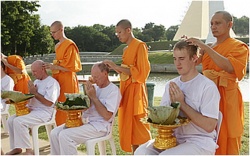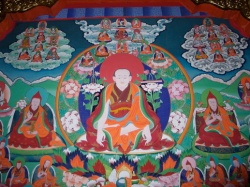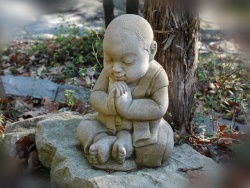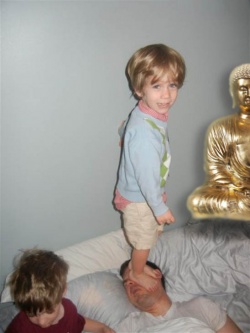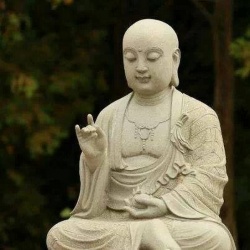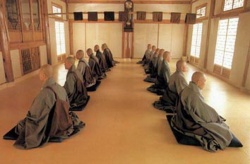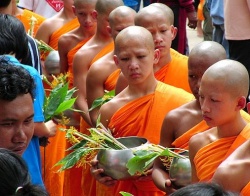Tibetan Oracles
In Tibetan tradition, the word oracle, or kuten, literally interpreted means “the physical basis.”
The word oracle is also used to define the spirit which enters into men and women who are acting as a medium between the spiritual and natural realms.
Oracles serve as a guide for Tibetans in political decisions, predictions about natural forces, etc.
Their decisions help guide internal and external affairs.
They most clearly demonstrate their function while in trance.
In this mind-altered state prophecies and predictions are made about questions asked.
Their answers are taken seriously by Tibetans and high-standing political and religious individuals.
The occurrences that take place while in trance cannot all be explained by scientific means and there is some spiritual force acting on the situation.
To fully understand Tibetan oracles and their trances, some background information about them must be given.
The first recognized Nechung oracle was realized in 1544 AD.
This was the first time that the spirit of Nechung was possessed in a human being.
The name of oracle was Drag Trang Go-Wa Lobsang Palden.
Many oracles used to be present in Tibet, but their numbers have diminished as a result of various factors such as Chinese occupation.
However, the phenomenon of oracles still remains central to Tibetan life.
The oracle is not only used to predict the future, but they are also sometimes used as protectors and healers.
The main function of [[oracles}} in Tibet]] is to answer tough questions about internal and external affairs both religious and political.
They way that this is most effectively performed and acted upon is through possession or trance induction.
Trance induction in the Tibetan State Oracle is a complex process involving certain physical deprivations and stimuli from various sources of anything from music to hyperventilation.
Symbolic elements as well as visualizations induce possession and trance in the oracle. (Ellingson 58)
Certain questions about the spirituality of the oracles arise.
It could be argued that oracles are taught to act in spiritual ways and that these actions are just reproductions of what they have been taught.
Indeed, oracles are taught certain methods of purification, but these methods are used so that the Buddhist conceptions of force and spirit can flow through this medium.
“The oracles body should not be available or used by any other forces.
To exclude this possibility, the person must be pure; if he is pure, he has his own special strength and there is no opportunity for other forces to use this body.” (Lipsey 267)
This demonstrates the attention paid to ‘pureness’ of the oracle is to make sure that the forces he undergoes are genuine and not the result of some false motive.
If it is the case that the oracle’s ‘pureness’ is brought into question, certain measures are taken.
It happens that sometimes oracles are dismissed from their position and denounced as being a true oracle.
This is a demonstration of the high standards these mediums are held to and not an example of the oracles being a sham.
If an oracle has been making false prophecies, they are reconsidered.
If the conclusion is made that they are not a true oracle, then they are expelled from their position.
Imposters do exist in the Tibetan oracles, but this does not mean there are not true oracles that are acted upon by unexplainable forces.
When an oracle is dismissed it is shown that Tibetans have found him either to be a fake or not pure.
“If the oracle plays a role, that means he is not in full trance and is faking.” (Lipsey 270) This could be a result of lifestyle.
If an oracle does not keep his mind clear through meditation, it makes sense how fallacious prophecies can be made.
It is a compliment to the Tibetan people and that they are able to recognize these imposters, and not a sign that the entire oracle system is a fraud.
“Individual traits do come out.” (Lipsey 263)
The existence of individual traits could be thought of as a reason for renouncing the idea that there are spiritual forces acting on the medium.
However, it can be used in the opposite way as well.
The oracles cannot be completely pure, so it makes sense that certain dissimilarities in trances would exist.
The same spirit may be represented slightly different in two mediums because it may be running into certain blocks that are unique to the individual.
Also, it is not always the same spirit that is speaking.
At times it can be a wandering spirit of someone who died.
Ambiguity in answers can also deter people from believing in the spiritual aspects of the oracles predictions.
An example is given of a woman who was having a baby.
She very much wanted a boy.
When she asked the local oracle, the response was: “Girl, no. Boy”.
She left the oracle excited about the prediction of the new baby boy.
However, when she gave birth to a girl, she came back to the oracle to show that his prediction was false.
The oracle’s personal aide that was present when the prediction was made about the baby answered the woman.
The aide stated the prediction was, “Girl. No, Boy,” instead. (Lipsey 274)
This is an example of how the oracle could answer with such a sense of ambiguity that either way his prediction will be correct.
Nonetheless, it could be argued that the one receiving the information must be able to interpret correctly the words of the oracle.
Next, authenticity in the trance must be checked.
For the trance to be genuine, no hallucinogens or intoxicants should be used.
If this was the case, then it could be argued that the trance is merely and alter-mind state induced by various drugs.
In Tibetan history, these objects play no role.
“Hallucinogens and intoxicants play no role in the Oracle’s trance induction;
in fact, their use is one of the kinds of fakery tested for in the official examinations of oracles and would-be oracles.” (Ellingson 59)
This shows that not only are these products and mind-altering drugs not used, but if found to be used by and oracle, they are disqualified.
This also helps to support the idea that spiritual forces are acting when the medium is in trance and not physical ones.
Other physical objections arise and question the nature of possession.
It is reasonable to question the effect of the large amounts of incense that is burnt during the oracle’s trance and the effect that it may have on the oracle.
The incense could be considered a mild stimulant equivalent to the effects of a cup of coffee in the morning.
The incense are not, however, enough of a stimulant to bring out possession.
The monks present would actually be more likely to go into trance if the incense had this effect because they drink very strong tea and are much closer to the incense being burned.
If it was the case that the incense had an effect, then it would make sense that the other monks present would also enter into trance.
Since this is not the case the idea that the incense leads the oracle into some superficial mind-altered state is false.
It is merely a ritual and does not act a an effective stimulant that would rule out the idea of a spirit taking possession.
Another reasonable hypothesis offered for the explanation of the trance is the Neher hypothesis.
This hypothesis states that that in order to induce trance, drumbeats (rhythmic driving by low frequency, indefinite-pitch sound stimuli) are synchronized with alpha rhythms in the brain.
For this hypothesis to be true a continuous drumbeat of eight to 13 drumbeats per second must present.
In the oracle’s case, the drumbeats begin at a rate of one beat every 35 seconds.
This shows the failure of the Neher hypothesis.
“Since the Tibetan rhythms are asymmetric and continuously variable, there is no continuous beat pattern that could satisfy Neher’s conditions.” (Ellingson 60)
Some people assume that the possessions or trances are mere cases of epilepsy. Tibetans are able to confront this doubt because of previous experience.
They are able to
“differentiate between a person who suffers from epilepsy, and those cases in which a man or woman is … ‘possessed’.
While in the former case medical help is sought, which goes in combination with the performance of appropriate ceremonies destined to appease or subdue those supernatural beings which are believed to send epilepsy,
special matters have to be adopted in the case of ‘possessed’ persons.” (De’Nebesky-Wojkowitz 416).
So it is shown that Tibetans have dealt with epilepsy in the past and have accumulated enough information and wisdom to differentiate between the two.
The trances that occur during puberty are simply stated: “not ordinary cases of epilepsy as had been often assumed” (416).
Some people make the mistake of classifying oracles going into trance as simply Tantric meditation.
Tantric meditation is different from trance and does not possess the same qualities of a trance.
The Tantric meditator does not lose consciousness and is neither displaced nor depersonalized.
Both of these aspects are clearly brought out in trance.
It may be the case that both Tantric meditation and trance are centered on an alternative reality and alternative states of consciousness, but Tantric meditation is mostly centered on yoga rather than possession by a spirit. (crook 27)
A hypothesis that frequently is offered for the natural explanation of the trance is the idea of hyperventilation.
There is some evidence of hyperventilation during the last stages of the ;;oracle’s possession, but it occurs long after the oracle loses consciousness and perception of his actions.
Because signs of hyperventilation are only noticeable after possession, it can be ruled out as a cause of possession.
Another reason that brings doubt to this hypothesis is that the physical changes that occur to the body occur before a type of hyperventilation is realized:
“the physical changes marked by his unfocused eye movements, drooping eyelids, and swelling of the face have already begun during this quiet period, and are well developed before the onset of hyperventilation.” (Ellingson 61)
There is a story about [[Tibetan oracles’ history that supports the spiritual influence on the medium.
Around the time of 1910 there was a vacancy at the Nechung Monastery, there was no oracle.
The Dalai Lama was in search of a replacement when the second Chief State Oracle plainly stated that there was a monk named Gyaltsen Tharchin who would become the next oracle.
There were no direct connections between the second Chief State Oracle and the individual he predicted would become the next oracle, and there was no clearer way for him to make this prediction.
After this information was presented, a search began for this monk.
Monasteries and high government officials began a search for this monk.
They asked monasteries to report if any monk had been going into trance lately. Sure enough they were given the name of Gyaltsen Tharchin as a monk exhibiting these such behaviors.
Gyaltsen was brought to the Dalai Lama, immediately went into trance, and was promptly named the new Chief State Oracle.
This is a very compelling case for the forces associated with the Tibetan oracles that is beyond explanation.
The second Chief State Oracle gave this name without knowing who this monk was.
When the search began for this replacement oracle they simply asked if anyone had been exhibiting signs of going into trance, and Gyaltsen’s name came up.
This phenomenon cannot be explained away.
Some outside force was acting when the prediction was made for the replacement oracle. (Lipsey 265-266)
The testing for authenticity of oracles is extensive, especially in the case of the Nechung Oracle.
The Tibetan government spends much time and makes it a priority that false, fake oracles do not make it as the Nechung Oracle.
The government worries about the leak of information.
They believe this can occur from a malignant spirit relating information through another medium by entering into the Nechung’s trance and from the medium himself, if he remembers aspects of the trance from not being completely unconscious.
This worries many government officials because many important foreign and domestic polices about Tibet are discussed with the oracle.
To prevent this from happening, the Nechung Oracle I watched very closely.
While in trance he must be in the ideal state of complete possession and total unconsciousness.
This scrutiny in testing keeps someone who is simulating trance from getting into a position where much damage could be done.
Other unique aspects of testing are as follows: the medium is presented with a box and must name its contents and the medium is requested to quote prophecies given in the past.
The first test of recognizing what’s inside the boxes presented is considered relatively easy.
The majority of the spirits are said to possess this power.
The latter of the test is considered to be significantly tougher and impossible to complete without the Protector being present.
The Protector is the spirit of the true oracle.
When the oracle makes a prophecy, the words are carefully recorded by a secretary.
With numerous prophecies on file, they ones administering the test can simply turn to a specific date in the past and request the information from the new oracle that was given.
For the oracle to be authentic and the Protector to be present, the oracle must be able to recite word for word the word the previous predictions of past oracles under the control of the Protector.
This second test is considered conclusive, and should be.
For an oracle under trance to be able o recite word for word past prophecies given implies that some other force is acting on the situation.
It would be impossible to memorize all of the previous prophecies given, and therefore, it must be the case that some spiritual force is involved. (Avedon 211)
Some may assume that the oracles are thoroughly trained to act in specific ways while in trance or to say certain phrases to seem more authentic.
This is not the case. “Strictly speaking, there is no training at all because the person – the medium himself – is neutral in the sense that he is not directly involved in the process of oracular activity.” (Lipsey 266)
Some of the higher ranking oracles go through some Buddhist training including yoga focusing on controlling inner energies and the nervous system, but they do not undergo this training until they have been identified as an oracle and been thoroughly investigated.
The Tibetan oracles are said to have a special kind of energy necessary for the powerful spirit to enter their body.
This energy is recognized around puberty when oracles-to-be fall into trance uncontrollably.
The unnatural effects on the body while in trance also serve to demonstrate the oracle’s lack of control over the situation and the presence of some outside factor.
One example of this is in the helmet that is worn by the oracle.
The helmet of the Chief State Oracle is made of pure gold and requires two men to carry it; however, when the medium is in trance he can easily balance the helmet on his head.
Under normal circumstances, the oracle would be unable to hold this weight, let alone make various movements while wearing this helmet.
“The moment the oracle’s body is possessed, his powers, strength, energy multiply many times over; there fore, he can carry the heavy helmet.” (Lipsey 270)
Also, the helmet is tied on very tightly when the oracle enters into full trance.
If this is tied too early, the medium will suffocate; if it is untied too late, the same will result.
When the oracle is in full trance, it won’t hurt him. (269)
Included with the helmet and other heavy, decorated garments the oracle wears a long-sleeved garment which is mostly yellow in color and is made of ‘heavy brocade’.
The dress worn during the trance is elaborate and confining. The medium’s ability to be so agile and free-moving is another magical aspect of the unconscious state.
Another hampering example of clothing worn is the boots. The oracle wears a pair of high boots that are very heavy with thick, broad soles which are turned upward in front.
For someone to be able to dance in these boots is a phenomenon in itself. (De’Nebesky-Wojkowitz 210-211)
Not only are these oracles able to dance and make very sharp movements impressive, but it has been recorded that at times the medium can “jump several feet high.”
(De’Nebesky-Wojkowitz 434) Along with this physical feat – in most cases – high levels of pain tolerance are exhibited. Of the examples researched, one of the most compelling occurred with the shield worn by the oracle.
In one case, the oracle began to beat his shield hanging on his chest with his hand until his hands were covered in blood.
The pain did not deter the medium because he continued to beat the shield with his knuckles again and again. An observed stated, “There could be scarcely any doubt that the medium was not simulating, but had fallen into a full trance.” (434)
The physical effects on the body can also show that uncontrollable nature of these trances and the presence of some undefined spirit.
The oracle’s eyes glaze over and the eyelids droop at the start of possession.
“When his eyes close and his head nods, the monks believe consciousness has become submerged in the god who enters him.” (Ellingson 59) The face of the medium swells to the point that his facial features and looks are barely recognizable.
When the medium is under possession, sometimes a sword is presented to the medium.
This occurs at the height of possession. The oracle is given the sword subsequently utilizes his enormous, unnatural strength to bend it either into a spiral or a ‘U’ shape. The strength exhibited is staggering.
A reporter who was present for this exhibition examined the sword after it had been bent to check its authenticity:
“a short sword was handed to the oracle who grasped the hilt with the right hand, and setting the point of the weapon against the right side of the of the strong leather belt which he was wearing underneath his apron he pressed against the sword until the blade was bent into a U-form. –
After the end of the ceremony I tried to bend the sword straight again, but without the slightest effect.” (De’;;Nebesky-Wojkowitz 434).
The sword is often kept and fastened to a wall above the entrance to a room.
It is believed that the bent sword is a deterrent to evil spirits and demons. This is the first test given when there are several prospective mediums vying for the ;;Nechung Chief State Oracle]] position.
The second test administered is just an observation of the effects of the trance and possession on the oracle.
Some of the indications that are looked for are as follows: saliva flowing from the oracle’s mouth at the beginning of the trace contains blood;
the tongue kept rolled backward and pressed with its tip against the upper palate when not speaking, and an outline of a thunderbolt visible on the scalp of the shaven-headed medium.
This thunderbolt is said to be from Padmasambhava subduing Pe har.
The final part of this test is to question the medium, again while in trance, about the past, present, and future.
It is believed that these series of tests are so vigorous that only the true medium, Pe har, will be able to help the rightful successor earn this coveted position.
The Tibetan oracle never remembers what happened while in trance.
If he did, in Tibet he would be considered a fake. This overall amnesia is a result of the magnificent stress placed on the body while in possession.
A personal account best describes the incident: “But all I know is that I wake up hours later with indescribable aches in every part of my body, and I feel the pain for days afterward.
It is not a pleasant experience, and the worst thing is that I never know anything about what I have done.”
(Ellingson 64) This fact is more data in favor of the idea that the actions of the oracle are completely out of his control.
This displays that indeed the oracle is under the direction of another force and is truly being used as a medium between the spiritual world and the physical world.
The trance performed by the Tibetan oracle is a unique case among other mind-altered, trance-like states observed.
The Oracle’s trance is proven to be fundamentally different from other trance occurrences.
Because of the unique qualities of the oracle’s trance, unitary trance theories fail in rationalization.
The trance of the Tibetan oracle “fails to support common physiologically-based theories, such as rhythmic driving or hyperventilation, as explanation for the trance induction.” (Ellingson 67)
The majority of Tibetan oracles experience their first trance at the time of puberty.
This is very interesting because these trances are not induced and are random.
This would suggest that the oracle is not in charge of falling into their position and that there are indeed spirits who choose specific individuals.
“The first fits occur spontaneously and mostly to the great alarm of the person who experiences them.” (De’Nebesky-Wojkowitz 416)
Many of the people who experience and realize these trances fear the responsibility of becoming an oracle because of the stress, strain, and pain which mediums experiences as a result of the possessions.
There were various expeditions to observe the oracles by members of the Catholic church.
Even though they prescribed to a different religion and set of beliefs,
they were still able to recognize that some spiritual agent was at work and it was not a simulation: “we do no believe that there is any trick or deception about [the oracles];
for from all we have seen and hear, among idolatrous nations, we are persuaded that the devil has a great deal to do with the matter.”
(Ellingson 55) The fact that the oracle under possession was thought to be possessed by the devil is not important.
What is important is that this observer was able to recognize a spiritual force acting and taking possession of the oracle while in trance.
Although this man was from another country and of a different religion, he was able to realize the trance of the oracle to be authentic and not a sham.
The fact is that the trance of the oracle is unique and unparalleled elsewhere in Buddhism.
The other rituals and meditations of Tibetan Buddhists “do not result in anything like the dramatic effects of the Oracle’s induction.” (a&h 62)
In other meditation states of Buddhism the meditator maintains full cognizance and control over his actions, unlike the oracle in trance.
Through this investigation, many unnatural and not normal occurrences are present within the lifestyle of the Tibetan oracle.
This demonstrated most clearly in the trance the oracle undergoes.
From the various information gathered it is reasonable to infer that there is and unnatural, spiritual force involved in the possession.
Westerners have trouble accepting this phenomenon as being something spiritual and attempt to use science to explain away the occurrences, but is seems that the Tibetans have the most precise and clear understanding of the happenings during trance.
Although some natural, scientific explanations can be used to address a few parts of the trance, there is enough that is unexplainable and not merely coincidence in trance that suggests the involvement of a spiritual realm.
The oracle acts as the medium that delivers the message of the spiritual realm into the natural world.
